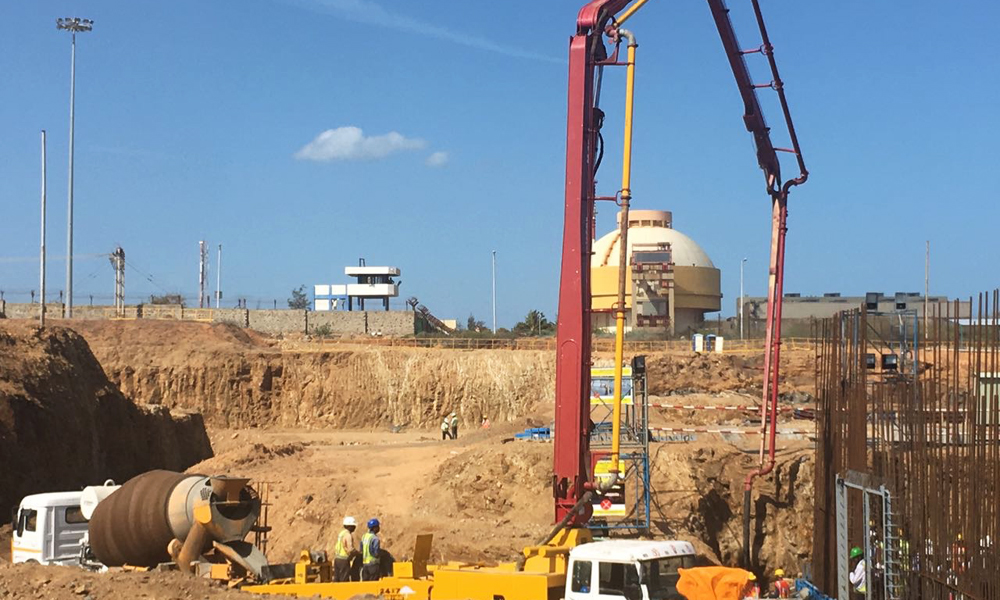
Equipment for Kudankulam Unit 3 Shipped to India
back to contents“We began loading the first vessel on 15 September. Nearly 13 thousand cubic meters of machinery and equipment are prepared for shipment. In particular, we are going to ship a condenser for Unit 3, heat exchangers, doors, leaktight penetrants, reservoirs, embedded parts, etc. All of them are needed to continue the installation process in accordance with the project schedule,” said Valery Limarenko, President of ASE. According to him, ASE plans to deliver two more shiploads by the end of the year to meet the contract.
In late June 2017, the first concrete was poured to form the foundation slab of Kudankulam Unit 3, marking the beginning of the second construction phase (Unit 3 and Unit 4) at Kudankulam. Also this summer, India and Russia signed a framework agreement to construct Units 5 and 6 of the nuclear plant. AtomEnergoProekt and AtomStroyExport (subsidiaries of ASE Group) will act respectively as a general designer and a general contractor for engineering, procurement and technical assistance.
Progress in cooperation
Speaking at the 61st IAEA General Conference, which took place in Vienna in mid-September, Rosatom’s CEO Alexei Likhachev announced that Russia and India had approved a site for a new Russian-design nuclear power plant. “The site and the nearest city were mentioned by India’s Prime Minister Narendra Modi during his meeting with Vladimir Putin at the BRICS summit, but the site’s owner should any way be the first to make an official announcement. Let’s wait for an official statement, although we have already got down to detailed discussions of contract terms and the number of units on the new site,” Alexei Likhachev said at a meeting with the press.
Kudankulam is one of the safest nuclear power plants in the world, with all post-Fukushima safety guidelines followed and safety systems working perfectly. Detailed design analysis of Units 1 and 2 shows that they would withstand a Fukushima-like disaster. Their active and passive safety systems ensure an unparalleled safety level and allow for prevention of any anticipated problems in operation. These systems include a double containment, which protects the reactor internals and neutralizes external impacts, a passive heat removal system, a core catcher and a closed water intake system. The facility is also well protected from natural and man-made disasters, including earthquakes, tsunamis, tornadoes and even plane crashes. Kudankulam’s tariffs on power generation are the most competitive in India and the entire region. Established by the Indian government back in 2010–2011, they have remained flat and not grown a bit since then. Power generated by Kudankulam costs only 4.10 Indian rupees per unit.
First concrete at Rooppur
This autumn, Rosatom also plans to launch construction of the first Russian-designed nuclear station at Rooppur in Bangladesh. “We are on the same page with our colleagues from Bangladesh. We are going to pour the first concrete this autumn,” he commented on the bilateral talks that took place on the sidelines of the IAEA General Conference. In mid-December 2015, Rosatom was awarded a general contract for the construction of a nuclear power plant in Bangladesh. In early 2017, the Russian government provided Bangladesh with a $11.38bn sovereign loan to finance the main construction phase at Rooppur. Two units to be constructed with Russia’s input will have a capacity of 1,200 MW each and are scheduled for commissioning in 2022 and 2023. The station will be built to the Russian design on the bank of the Ganges, 160 km away from the country’s capital Dhaka.
Rosatom’s CEO also touched on the topic of cooperation with China. He mentioned a recent bilateral meeting at which the two countries had discussed all current nuclear projects in China and plans for the future. Rosatom is engaged in the construction of Tianwan nuclear plant, which is the largest project delivered jointly by Russia and China. Unit 3 and Unit 4 with VVER-1000 reactors are about to be completed. Commercial operations at Tianwan Unit 3 are planned to begin in 2018. Nuclear fuel was loaded into Unit 3 in August.




